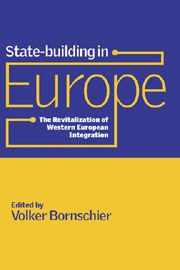Book contents
- Frontmatter
- Contents
- List of figures and tables
- List of contributors
- Preface
- Acknowledgements
- Part I State-building and Political Entrepreneurship
- Part II The Core Elements in Recasting the European Bargain
- Part III Conclusions beyond the Single European Act of 1986
- 7 Lobbying for a Europe of big business: the European Roundtable of Industrialists
- 8 Biotechnology in the European Union: a case study of political entrepreneurship
- 9 European integration after the Single Act: changing and persisting patterns
- 10 The state of the European Union
- Appendix List of interview partners
- Bibliography
- Index
8 - Biotechnology in the European Union: a case study of political entrepreneurship
Published online by Cambridge University Press: 10 October 2009
- Frontmatter
- Contents
- List of figures and tables
- List of contributors
- Preface
- Acknowledgements
- Part I State-building and Political Entrepreneurship
- Part II The Core Elements in Recasting the European Bargain
- Part III Conclusions beyond the Single European Act of 1986
- 7 Lobbying for a Europe of big business: the European Roundtable of Industrialists
- 8 Biotechnology in the European Union: a case study of political entrepreneurship
- 9 European integration after the Single Act: changing and persisting patterns
- 10 The state of the European Union
- Appendix List of interview partners
- Bibliography
- Index
Summary
‘Just as “telematics” and its various areas of application were the focal point of technological, scientific, and human activities in the 1980s, experts believe that the biological revolution unleashed by discoveries of biotechnology will become the greatest challenge of the 1990s.’
Etienne Davignon (1981: 189f, my translation)Introduction
In this chapter we examine the question of whether technology corporatism – established at the beginning of the 1980s – also flourishes beyond the domain of information technology, where it was initiated (see chapter 4). Moreover, we consider whether it shaped Europe's competitive position in biotechnology, an industry widely considered to be among the most dynamic in the twenty-first century.
The starting point of a European biotechnology policy was the Commission's insight at the beginning of the 1980s that the Community displayed a technological backwardness with respect to the USA and Japan and that bio-industry could make a decisive contribution to resolving the employment problem. Therefore, by the middle of the 1990s, the advancement of biotechnology was to become – as Davignon predicted above – an established goal of the technology policy of the European Union. Consequently, the Commission pushed for research programmes and a corporatist policy formulation process that included the participation of the interest organizations of bio-industry.
In contrast to information technology, however, the ‘national champions’ in the chemical and pharmaceutical industries were not very interested in European research programmes similar to Esprit (see chapter 4). Indeed, they had already established transregional alliances even before the first programme was launched and preferred competitive to pre-competitive research. Yet, during the 1990s their industry associations closely cooperated with the Commission because they regarded existing regulations as too restrictive.
- Type
- Chapter
- Information
- State-building in EuropeThe Revitalization of Western European Integration, pp. 210 - 243Publisher: Cambridge University PressPrint publication year: 2000
- 1
- Cited by



